Genesis: A Creation Story Inspired by Modern Physics
9 December 1997

www.integralscience.org
Abstract: This paper presents a creation story inspired by modern physics, with a focus on the first stages of cosmic evolution. The creation of the cosmos is characterized as a process of successive division and differentiation of an original and underlying unity. This process of creation is characterized by stages or epochs separated by relatively sudden transitions from one form of order to another. These sudden transitions may be understood as the breaking of symmetry, and are associated with the creative emergence of a new type of order. After this description of the evolutionary structure of the cosmos, the paper turns to some speculations on its psychological significance. In particular, it is proposed that the spatiotemporal cosmic process revealed by physical science is an outer reflection of an inner process in the depths of the collective psyche.
Before the Beginning
The entire universe--matter, energy, space and time--burst into existence about 15 billion years ago from what appears to be a singular point of infinite potential and impenetrable mystery. Because space and time themselves did not yet exist in this mysterious origin, we cannot say where the universe came from or what existed before it. Without space, there is no "where". Without time, there is no "before". Beyond our capacities to sense or even to conceive, this cosmic Mystery abides eternally ever present in the heart of all things. We and the cosmos are none other than this Mystery.
Unity
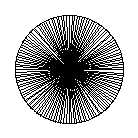
In the first moments of creation, the universe was in a state of unity, a singular point containing all possibilities for the manifestation of energy, matter, space and time. Full of infinite potential, the universe contained implicit within itself the vast expanse of intergalactic time and space, the fundamental forces and particles, the wondrous varieties of matter and energy, and the subtleties of complex organizational patterns that would later unfold in the forms of galaxies, planets, and life. All this diversity of form, however, was present only implicitly in the singular unity of this primordial seed. The cosmos at this stage manifested only the quality of unity, having no distinguishable forms of manifestation, not even space or time.
In this period, there were no meaningful distinctions between any of the different fundamental particles or forces--they were all unified in perfect symmetry. The energy density was so high that it permitted complete freedom of transformation of any form into any other form, so that no particular form of manifestation was dominant, and all were in equilibrium with each other. All the stable forms we know in our present low-energy world could not exist in this flux of completely free and unrestricted transformation. Even the forms of space and time were not distinguishable from matter and force particles, since spacetime fluctuations could be transformed into matter and vice versa. The matrix of spacetime was melted together with its material content.
Although we may speculate about this original singularity, no theory of physics presently provides a model of this state where even time and space do not exist. The holy grail of physics is to discover a theory of everything (TOE) that describes this period of ultimate symmetry. For now, however, all our current theories must be left behind to enter this primordial era called the Planck era.
The Birth of Gravity
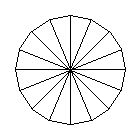
Around the time of ~10-43 s, the perfect symmetry of the Planck era was broken, giving birth to space, time and gravity. The energy density of the universe at this time dropped below the critical Planck energy ~101932 K), resulting in a restriction or limitation of possible transformations between forms. Interactions that mix the gravitational force with the other forces require a minimum energy of ~1019 GeV. As the average energy density of the universe dropped below this critical threshold, these interactions were no longer possible, and so gravity, space and time emerged as stable structures of manifestation. Just as ice comes into being by cooling water below a critical freezing temperature, when the universe cooled below this "freezing temperature" of ~1032 degrees, the threads of reality spontaneously self-organized into a coherent fabric of space and time. GeV (~10
This restriction of possible transformations distinguished the unified action of the universe into two separate interactions: the force of gravity and a grand unified interaction. We understand these two interactions today with Einstein's theory of general relativity and (somewhat speculative) grand unified theories (GUTs) of the fundamental particles and interactions, respectively. Einstein's theory governs the dynamics of the fabric of spacetime, while GUTs govern the dynamics of the remaining interactions. These apparently distinct interactions, however, are the manifestations of the possibilities present in the original unity, brought into existence through the process of limitation and restriction. Like an exquisite Persian carpet, the underlying fabric of space and the dance of form upon it are both woven of the same thread.
The dance of form within spacetime has a grand unified symmetry called SU(5). This symmetry is less than the perfect symmetry of the Planck era, but is still a high symmetry compared to the symmetry manifest in the present state of the universe. If we represent perfect symmetry by a circle which has complete rotational symmetry, then the SU(5) symmetry might be symbolized by a regular 16 sided polygon which has a high but incomplete rotational symmetry. At these high energies, this symmetry allowed the transformation between all types of particles. In particular, a super-massive particle called the X-boson mediated the transformation between quarks and leptons, the two fundamental types of matter. Thus, at this stage in the evolution of the universe, no type of material particle has a stable existence and no orderly structures are manifest.
The Birth of the Strong Nuclear Force
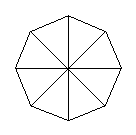
At about 10-35 s, when the universe was the size of a grain of sand, the energy density of the universe fell below the critical level of ~1015 GeV (~1028 K), giving birth to the strong nuclear force. This energy is the minimum energy required to create the X-boson which mediates the transformations between leptons and quarks. Because X-bosons were no longer created, the transformations between the quarks and leptons were suddenly prohibited. The SU(5) symmetry of the grand unified interaction that had been present broke apart into two separate symmetries: an SU(3) symmetry that governed the strong nuclear force, and an SU(2)xU(1) symmetry that governed the remaining electroweak force. As before, because a mode of transformation was restricted, a distinction became manifest in the form of two separate classes of material particles.
This symmetry breaking was actually postponed until slightly after the universe cooled below the critical temperature. Like supercooled water that suddenly freezes below the freezing temperature, the SU(5) symmetry broke slightly below the critical temperature. The sudden release of energy resulted in a dramatic cosmic inflation and the precipitation of huge amounts of matter. The period of sudden cosmic inflation lasted from about 10-35 s to about 10-32 s.
The Birth of the Weak Nuclear Force
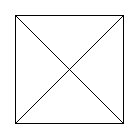
The universe continued to expand, dropping in energy density by a factor of 1013 to ~102 GeV (~1015 K). Then another phase transition took place at about 10-10 s, resulting in a further break in symmetry. The electroweak interaction separated into the weak nuclear force and the electromagnetic force. The weak force interacts with particles having a flavor charge, while the electromagnetic force interacts with particles having an electric charge. Before this break in symmetry, there was enough energy present to freely create W and Z bosons, which carried the electroweak interactions. After the symmetry break, however, there was no longer sufficient energy to create the W and Z particles, and only the photons remained plentiful in the universe. At this point, all four fundamental interactions were distinguished and the stage was set for the creation of complex forms of matter.
The stages up to this point are characterized by the creation of distinctions between the fundamental interactions, represented by successive breaks in symmetry. The initial state of unity may be symbolized by a highly symmetric circle, while later stages are regular polygons having fewer and fewer sides. Taken together, we can construct a pyramid-like structure by stacking these planar figures upon each other.
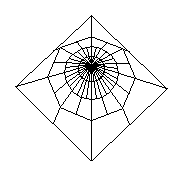
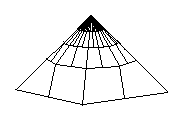
At the apex of this structure is the original mystery where all distinctions dissolve into a single point, and all forms and structures are implicit. Moving down from the apex, space expands and the local symmetry at that stage successively breaks until, at the bottom, the universe has the four-fold symmetry of a square, representing the four fundamental interactions, the four elements of earth, air, fire and water, or the four directions. With each break in symmetry, an implicit, potential form of existence manifests as an explicit form of existence. At the same time, the explicit unity that had been manifest before the break in symmetry then becomes implicit. Our origin, therefore, is exists implicitly in the present, even though it may not be explicit.
The Birth of Hadrons
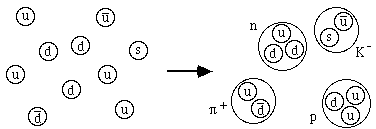
In the next stages of cosmic evolution, the transitions are no longer associated with the creation of new forms through division, but through collection of existing forms into new composite forms. Quarks collect to form nucleons, nucleons collect to form nuclei, and nuclei bind to electrons to form atoms. These stages of evolution, therefore, may be called the stages of collection.
When the universe was 10 microseconds (10-5 s) old it had cooled down to about 3 trillion degrees (~3x1012 K, ~300 MeV). Before this time, all particles were freely interacting individuals. Below this critical temperature, however, the quarks no longer had enough energy to overcome the attractive force between them. As a result, the quarks collected together in groups of two and three. Groups of two quarks formed a class of new particles called mesons, while groups of three quarks formed a class of particles called baryons. These novel organizational structures marked the manifestation of composite forms that were only possibilities at higher energies where quarks were free. Thus it was through the limitation of freedom that new forms of order became manifest. The process of manifestation, in other words, is the transition from manifest freedom and potential order to manifest order and potential freedom.
Due to the action of the weak force, the baryons freely transformed into each other, as did the mesons. By about a tenth of a second (10-1 s), however, the energy density had dropped below 1 MeV (3x1010 K). Below this energy the neutral current weak force interactions were limited, causing neutrinos to decouple from other matter, and the universe thus became transparent to neutrinos. By one second (101 s) the energy had dropped to about 300 eV (1010 K) and the charged current weak force interactions were limited, causing the proton to be more stable than the neutron. The other baryons and mesons were relatively unstable particles and decayed into protons, neutrons, electrons, neutrinos, and/or their antiparticles. The protons and neutrons, therefore, were the only hadrons to endure past this stage.
The Birth of Nuclei
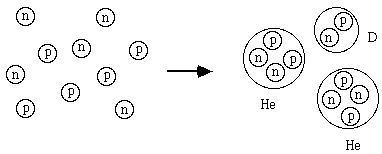
From about one second to three minutes (101 s - 102 s) the energy density dropped from 1 MeV to 0.1 MeV (109 K - 108 K). At these lower energies, the protons and neutrons were able to bind together to form small groups called nuclei. The protons and neutrons were held together by the strong nuclear force, much like how atoms are bound to each other by electromagnetic forces. The nuclei formed in this process were only the very lightest: D, He-3, He-4 and Li-7. Larger groups were not produced because the density of protons and neutrons was too low. Moreover, the density continued to drop as the universe expanded, so that by the time these first three minutes had passed, the protons and neutrons were so far separated that the reaction could no longer take place. At the end of this process there was about 3/4 of all matter in the universe was still protons, and just less than 1/4 was converted to Helium nuclei. Only tiny fractions of D, He-3, and Li-7 were produced.
The Birth of Atoms
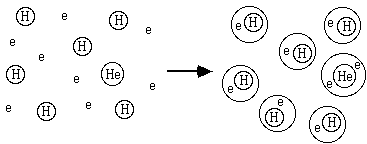
When the universe was about 100,000 years old (1012 s), it had cooled to around 4000 K (1 eV). At these energies, the free electrons became bound to the H and He nuclei to form atoms. Thus the universe transformed from a charged plasma of free electrons and nuclei to a gas of neutral atoms. The birth of stable atoms also makes possible all of chemistry and the complex forms that can emerge through the combination of atoms. At this point in the evolution of the universe, however, only H and He atoms exist. Because simple cooling of the universe was not sufficient to create further composite structures, this marked the end of the stages of creation by collection. Further stages of creation required the emergence of a new kind of creativity.
Shortly after this phase transition and the emergence of neutral atoms, the photons decoupled from matter and the universe suddenly became transparent to light. With light no longer scattering off matter and creating pressure, all forces but gravity lost their global influence and gravity emerged as the dominant force of further evolution.
The Birth of Galaxies and Stars
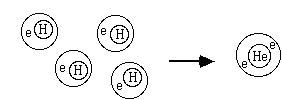
In the previous stages of cosmic evolution, the universe was largely homogeneous and uniform, and the stages were associated with decreasing density and decreasing energy. When gravity emerged as a dominant force of evolution, however, small fluctuations in the distribution of the H and He gas provided gravitational attractors that were seeds for the condensation and heating of the gas into gigantic clouds separated by vast expanses of space, eventually giving birth to large structures that are gravitationally decoupled from each other. Through the further action of gravity, these clouds organized themselves into complex galaxies and groups of galaxies. At this time, the universe was approximately a billion years old (1016 s) and the average energy density had dropped to 10 K. In these galaxies, however, the movement of the cosmos toward lower density and heat had reversed its course, giving rise to a dynamic form of creativity unprecedented in the history of the universe: stars.
Within the galaxies, the gravitational action led to more localized clouds of H and He. These clouds had a wide variety of sizes. If a sufficient amount of gas was collected in the cloud, its own gravity continued to pull it together against its own heat to the point where the temperature in the cloud rose back up to the point where the atoms transformed back into a plasma. This phase transition momentarily reduced the outward pressure of the heat, allowing gravity to compress the hot cloud. Eventually, if the cloud was large enough, the gravity compressed the hot plasma to the point where the temperature was high enough that nuclear reactions begin converting H to He within the core, releasing tremendous amounts of energy. The possibilities that were lost when the nucleosynthesis stopped were again released in this remarkable creative being. The birth of the star was a new and dynamic form that was made possible by the matter in the gas cloud reversing the course of cosmic evolution to tap into its own higher energy state of greater possibility and potential.
The dynamic balance between gravity and heat is the hallmark of a star. In the life of the star, it passed through cycles where H was first transformed to He for 107 years; then a shift to a new dynamic balance allowed the transformation of He to C for 105 years. This new element C emerged into existence for the first time due to the creativity of the star. If the star was large enough, another shift allowed the conversion of C to O for 103 years, then from O to Ne for 1 year, from Ne to Mg, from Mg to Si, and from Si to Fe. These higher elements were created for the first time in stars, ushered into manifestation by the delicate balance between the interactions of the cosmos.
If the star was extremely large, its death was a sudden and super explosive self-destruction called a supernova. The star blew itself apart, blasting its creativity out into space. The higher elements which were scattered in that catastrophe later collected together to form planets with complex chemistry involving not just H and He, but C and O and N and many other elements as well. These planets would be cold and lifeless, however, without the formation of a new second-generation star nearby. Such stars are not born in just any galaxy, however. Only the elegant spiral galaxies possess the delicate organization which has the capacity to support the ongoing creation of stars, and hence the possibility for chemistry, and for life.
The Birth of Life
Out of the creativity of stellar destruction, second generation solar systems were created with the possibility of complex chemistry and life. Powered by the continual sacrifice of energy from a nearby star, patterns of matter evolved into higher and higher forms of complexity. First organic molecules, then simple self-replicating molecules. Later these molecules organized themselves into complex cells, and eventually the cells organized themselves into exquisitely delicate multicellular organisms. Millions of plants and animals lived in a dynamic process of interdependence and continual transformation. all in complete dependence on the solar outpouring of light. Never before had the universe manifested such a degree of order and beauty.
The Birth of Self Consciousness
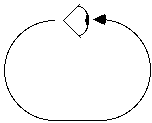
A wondrous form of life emerged in the universe after 15 billion years. The complexity of life had increased to such a degree that the universe became capable of representing itself to itself. The universe, in short, became self conscious. First only dimly, but later more pronounced. These creatures were called homo sapien sapien, the humans who knew that they knew. Through this self-reflective activity, they served as the instrument through which the cosmos knew that it knew itself. Eventually, they developed extremely subtle and refined forms of knowledge, which reflected to them the nature of the cosmic laws and revealed a grand story of creation, starting from an unknown singularity. In the first phase of cosmic evolution, the unity divided and forms manifested through restriction of possibility and limitation of freedom. After this initial period, however, a remarkable dynamic process of creation emerged that involved an interplay of the high and low energy. Freedom and restriction danced with each other to spin out of the web of existence marvelous forms of complexity and wondrous structures of manifestation, leading up to these very creatures themselves. Thus, this story itself was a manifestation of the capacity of the universe to know that it knows, and to consciously participate in its own creative process.
This story of the cosmos is none other than the story of ourselves. It is necessarily self-referencing, ending finally at the present with the very creatures who are capable of representing to themselves a story of the cosmos which created them. The story tells us about ourselves as a particular form of creation, and also ourselves as the cosmos itself. But this story, which is a narrative in time and space, also points beyond itself, beyond time and space to the origin out of which time and space emerged. It points outside of all narrative to an original mystery transcending this story, to a reality transcending the structures of space and time within which all forms of manifestation exist, and within which all stories take place. This mystery is the source of all existence, the ground of all being. As our story itself has revealed, all varieties of structure, interaction, process, and form are derived from this mystery. This mystery, however, is not separate from the universe. Just as the potentiality of hot stellar fusion reactions is latent in cold galactic clouds of gas, so the high energy potentialities prior to the emergence of space and time are latent in and throughout the entire cosmos, and even ourselves. The mystery is an immanent presence throughout all existence.
If the potentialities of the entire cosmos exist implicitly, then they must exist within ourselves. Could it be possible that we are more intimately connected to the cosmos than we normally suppose, that our psyche and our cosmos have some kind of profound connection? Mystics, saints, sages, shamans, and many other visionaries among our species have testified that there is such a connection, and that--in some sense--to know ourselves is to know the world. The cosmos and the psyche are two sides of the same coin, reflections of each other.
If we consider this proposition seriously, we might discover that cosmology has many things to teach us about psychology, and vice versa. For example, consider again the story of the cosmic evolution as beginning with the mysterious origin, then progressing through stages of division, collection, then complex transformation. Reflecting upon this cosmic evolutionary structure suggests that we may have an analogous psychological evolutionary structure starting with a mysterious origin transcending time, space, and language, then progressing through stages of further limitation and restriction until we arrive at our present state of being. Indeed, this description is very similar to the testimony of many contemplatives. Moreover, the cosmic story reveals to us that the mysterious origin exists implicitly everywhere, even though it may not exist in explicit manifestation. This suggests that our inner origin is also everpresent in our being, existing implicitly in every inner state. This teaching also can be found in the contemplative traditions.
Our physical inquiry into the cosmos has revealed that the forms of existence we normally consider stable are not at all stable at higher energies. The world we often consider to be so real is actually a partial manifestation of a much larger reality that permits exotic transformations that would literally dissolve the very fabric of our world. To understand the cosmos, we have to break out of partial views of reality and expand our understanding to comprehend higher symmetries and higher energies. Translating this lesson to psychology, we must consider the possibility that our conception of our inner psyche is only partial, and that a complete exploration of our psyche will require us to dissolve existing psychological structures and radically transform our ideas of who we are and what really exists. Complete self-knowledge would require, just as the contemplatives have testified, the complete transcendence of all inner forms and structures and the realization of the inner ground of being as the immanent potentiality for all creation.
| Period | Emergent Interaction/Structure | Time (sec) | Energy (GeV) |
| I | Unity | <10-43 | >1019 |
| II | Gravity, Space, Time | 10-43 | 1019 |
| III | Strong Force, Quarks, Leptons | 10-35 | 1015 |
| IV | Weak Force, Electromagnetic Force | 10-10 | 102 |
| V | Hadrons (Protons, Neutrons) | 10-5 | 10-1 |
| VI | Nuclei (Hydrogen, Helium nuclei) | 102 | 10-4 |
| VII | Atoms (Hydrogen, Helium atoms) | 1012 | 10-9 |
| VIII | Galaxies, Stars, Heavy Elements | 1016 | 10-11 |
| IX | Chemistry, Elementary Life | 1017 | 10-12 |
| X | Self-Consciousness | 1018 | 10-12 |
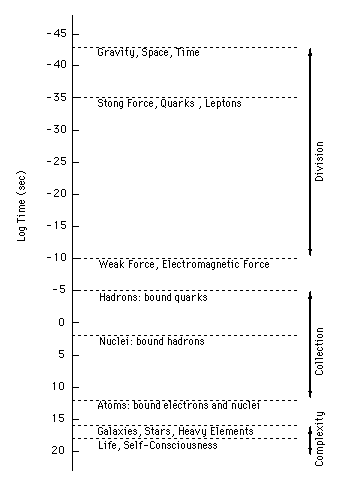
No comments:
Post a Comment